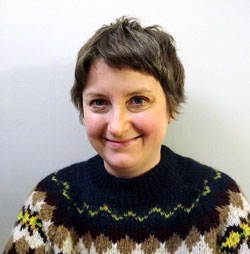of British Folk Art
Interview by STEPHANIE PETERS

Selected group exhibitions include: Derwent Art Prize (2020); Derwent Art Prize (2018); Trinity Buoy Wharf Drawing Prize (2018); Jerwood Drawing Prize (2017).
Recent awards include: Drawing Projects U.K., Wiltshire – Drawing Residency (2016).
How would you define your style?
I am a collagist who creates imagery in response to objects and events. Social history, artifacts, and artworks in museum and gallery collections act as a catalyst for ideas. Diverse ranges of influences play a part in my work, including British folk art, textiles, and children’s drawings.
Your pieces simultaneously have a folk art and contemporary feel. Is this an intended objective?
My method of making collages is driven by the use of found, humble materials, which has emerged via a synthesis of the non-verbal forms of communication rooted in the practices of drawing, collage, and British folk art. This investigation has created a visual dialogue between regional heritage, social class, rural landscape, and human and non-human relations that are at the forefront of the field of contemporary drawing.
Does working in collage add to that mood? What are your preferred materials for your mixed media pieces?
Modest materials such as pencils, pencil crayons, and gouache are used in conjunction with found surfaces. The discoloration, stains, tears, and scale of used book jackets and jigsaw boxes set the parameters for each drawing, and each must respond through a dialogue of image, mark, and surface. This strategy borrows from folk art processes whose use of found materials, varying levels of technical skill, and “idiosyncratic construction” are instrumental to the genre’s “marginal status.”
Animals, particularly horses, are a reoccurring motif. What makes them such interesting subjects for you?
Here, in Yorkshire, we have a deep connection to horses. Malton (where I am based), located on the edge of the North Yorkshire Moors, is renowned for its importance in the breeding, training, and selling of horses; most famously for the Darley Arabian, a stallion imported from Syria in the 18th century and the most popular stud in England. He is one of three foundation sires to whom all modern Thoroughbreds can be traced. The horse racing community is a microcosm of class relations, from stable boys and girls, jockeys, trainers, owners, and punters, up through the aristocracy.
Do any particular primitive or folk artists inspire you? What about historical periods?
Folk art has made the horse instrumental in the identity of Yorkshire’s Hambleton District through the monumental Kilburn White Horse, cut into the hillside in 1857 by schoolmaster Thomas Taylor and his pupils. In particular, the Horse Series takes inspiration from works such as George Smart’s Old Man with Donkey (1833), which depicts characters and habits of daily life through a collage of textiles taken from his trade as a tailor.
I am interested in visually exploring the significance of a region’s past to enrich its cultural life in the present.
Can you tell us about The Shop Floor Project and how you are collaborating? Do you enjoy seeing your work translated into pieces of home décor?
The Horse Series collages are available to purchase at The Shop Floor Project (TSFP). Exploring ideas around folk art and the home, I was commissioned to create designs featuring the horse to be made into luxury cushions. The Shop Floor Project specializes in working with artists who create objects to be enjoyed and passed down through generations in the family; this certainly appealed to me, given my interest in history and folk art.
Has the collaboration contributed to your creation of textile works?
I’ve always had a textile strand to my work; I see it as a form of collaging and nearly always have a quilt or sewing project on the go. Keen to explore this further, TSFP commissioned me to do a series of works exploring the countryside, rural industries, and customs, which will be launching in the near future.
Do you have any new artistic avenues you’d like to explore?
The Horse Series is ongoing. I’m currently researching and producing work about Shire horses and how they are becoming a rarity. I’m also making collages and models inspired by antique decoys of geese.







